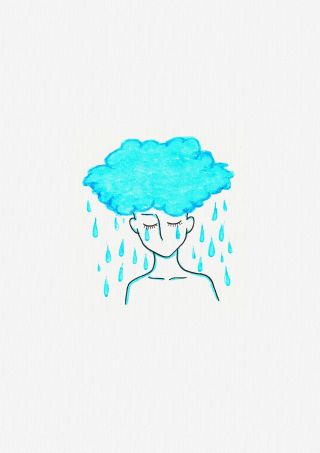Anxiety
How Curiosity Can Help Ease Anxiety
Find out how to become disenchanted with worry.
Posted May 3, 2023 Reviewed by Davia Sills
Key points
- Anxiety can be driven as a habit by triggering worry as a mental behavior.
- Despite the false sense of control, worrying isn’t helpful.
- Curiosity is more rewarding for our brains than worry.

If it takes 10,000 hours to master a skill, then most of us are expert worriers. Like seasoned musicians with their cherished instruments, worrying comes easy to us. We, too, are quick and nimble in playing the mind’s keys to compose our cacophonous masterpieces. In moments of flow, we, too, become one with our anxious ruminations and lose track of reality. We, too, are staggeringly creative: Even when things are going well, we agonize over imagined reversals of fortunes.
Banishing worry from our lives altogether may be a tall order. But what is possible is to change our relation to it, to hold our instruments with a lighter grip. Better yet, to get thoroughly disenchanted by it.
Neuroscientist and addiction psychiatrist Jud Brewer has witnessed this disenchantment first-hand. Brewer works with patients afflicted with various harmful behaviors. With anxiety, since medication benefits only one in five people, Brewer turned to neuroscience to help his patients understand the mechanisms of their behaviors ranging from anxiety to overeating to addictions. After all, he says, working with the mind is easier when you know how the mind works. By learning to map their habit loops, Brewer’s patients have experienced five times the quitting rates for smoking compared to gold-standard treatments and significant (40 percent) reductions in craving-related eating.
Studying addiction in the brain led Brewer to a profound insight: Anxiety could be driven as a habit by triggering worry as a mental behavior. Moreover, the inner tool that could help break this pernicious habit is not mighty willpower but humble curiosity. Brewer calls curiosity a superpower based on its far-from-humble effect on our psychology.
As for himself, anxiety still pays Brewer’s mind a visit from time to time. But it no longer sticks around for long. “My brain is just not that interested in worrying anymore,” says Brewer, “maybe because it hasn’t gotten me anything yet.”
Here’s Brewer on how to “unwind” anxiety.
MP: How do anxiety and worry become a habit?
JB: Worry can be a noun (the feeling of worry) and a verb (to worry). We don’t have control over feeling worried. But worrying as a mental behavior is a habit that we can let go of.
Worrying makes people feel like they’re in control and can act as a distraction from the unpleasant sensations of anxiety. Despite the false sense of control, worrying isn’t helpful in taking charge of the future. Ironically, it makes it harder for us to think and plan. However, worrying is rewarding enough that it feeds back into the reinforcement loop that drives the anxiety-worry-anxiety cycles. We feel anxious, then we start to worry, and that worrying makes us more anxious.
MP: How can we break the habitual cycle of worry?
JB: There are three steps to habit change.
Step 1: Identify the habit loop.
What is the behavior (worrying), and what’s causing it? Simply notice when you’re worrying. Without recognizing the behavior, we’ll be on autopilot and, therefore, won’t be able to do anything.
Step 2: Update the brain’s reward value of the behavior.
Our brains keep doing things that are rewarding and stop doing things that are unrewarding. To update the brain’s reward hierarchy, pay attention when you do the behavior. Often, we don’t realize that our learned behaviors are, in fact, not very rewarding.
For example, when my patients who want to quit smoking pay close attention to when they smoke, they realize that cigarettes taste awful. Without paying attention, they won’t get that negative prediction error, and their brains will keep expecting smoking to deliver rewards. In other words, they won’t realize that smoking is actually worse than expected. The same is true with worrying. We assume that worrying is helpful because we worry continuously without paying attention.
To break this cycle, ask yourself, “What am I getting from this behavior?” Don’t think intellectually about the answer. Rather, feel it in your direct experience. Worrying doesn’t feel good. And it doesn’t solve the problem because if the problem were solved, we would stop worrying. We have to see clearly that the behavior is not actually helping. In fact, it’s making things worse—we get tightened into a contracted ball of anxiety. When our brains perceive the behavior (worrying) as not actually rewarding, we start becoming disenchanted with it.

Step 3: Find a bigger, better offer.
Offer your brain something more rewarding to do: get curious. When anxiety begins to emerge, compare “How does it feel when I’m worried?” with “How does it feel when I’m curious?” When we’re curious, we can start to relate to our experience differently: “Oh, these are thoughts and feelings. I don’t necessarily need to do something about them.” Ironically, the less we do, the more quickly they go away on their own. As we learn to be with our experience by being curious about it, being becomes the new doing.
When we teach this three-step process of meeting worry with curiosity in randomized control trials, people with generalized anxiety disorder show a 67 percent reduction in anxiety—the number needed to treat was 1.6. This is much more effective than medication, where the number needed to treat is 5.2.
MP: Doesn’t worrying sometimes help us think through our problems and come up with solutions?
JB: When we worry, we get stuck in the same thought pattern over and over again. It doesn’t actually change anything or help us solve problems. But it can falsely be associated with planning and reasoning. When we plan and reason, we’re thinking through a problem a couple of times, but not 20 times.
Sometimes, if people spend a lot of time worrying and suddenly, by chance, they have an insight, they’re going to associate those two. That’s the fallacy of correlation. It doesn’t mean that the solution they came up with was because they worried.
Planning is very different than worrying. We only think that we can worry our way through problems in order to resolve them. Consider how much time you are spending on thinking about something. If we keep examining the same angle from the same thought pattern while expecting different results—that’s not helpful.
MP: Can we separate worry from thinking productively to solve our problems?
JB: We can’t say, “I’m going to place my worries aside and think through this problem logically.” Most of us don’t have that cognitive control. What we do have is awareness. Instead of trying to separate worry from reasoning, we can become disenchanted with the worrying itself. Then it becomes easier to let go of worrying instead of trying to force it off to the side. It’s not about getting rid of thoughts and emotions—it’s about how we relate to them.
MP: Why is it less effortful to worry than to get curious?
JB: Because worrying is an old, familiar habit, it’s easy to fall into. The good news is that once we grow curiosity as a habit, it becomes less effortful. I have patients who have learned to tap into curiosity in the middle of a panic attack. Being curious is not effortful for them, even in those difficult moments, because it’s their new habit. Our habits become our easiest behaviors. As a habit, curiosity brings energy to the equation instead of sapping it.
MP: How can we remember to bring in curiosity when we are stuck in rumination?
JB: Knowing about curiosity intellectually will not turn it into a habit. We have to experience how good it feels to be curious. To form a habit, repeat a behavior over and over again. Short moments, many times.
Anytime we notice that we’re naturally curious and how helpful it is to be curious, reflecting on it can grow its reward value. We can also practice curiosity throughout the day. For example, when we’re in a conversation, we can explore, “Am I actually interested in what the other person is saying? Or am I already planning my response?”
As soon as we start comparing those two things, our brains are going to weigh curiosity as the bigger, better offer. Curiosity feels better than judging or waiting for our turn to jump in. When we start noticing the joy and ease that emerges from expanded mental states, such as curiosity, kindness, and connection, in the moment, we’ll grow them as habits.

MP: How can we learn to let things go?
JB: The key is to see how painful it is to hold on. Imagine holding on to hot coal because somebody told you it was going to keep you warm. When you start paying attention, you’ll see that your hand is burning. That’s when you naturally let go of the coal.
Similarly, when we see how unrewarding holding on or pushing away is, we’ll start letting go. What are you getting from worrying? Seeing how painful the identification with our behavior or experience is can make it easier to let it go. And when we experience how good letting go actually feels, our mind will naturally incline in that direction.
Many thanks to Jud Brewer for his time and insights. Dr. Brewer is the director of research and innovation at Brown University’s Mindfulness Center and an associate professor in Behavioral and Social Sciences at the School of Public Health and Psychiatry at the School of Medicine at Brown University. His latest book, Unwinding Anxiety (2021), became a New York Times bestseller. Additionally, Dr. Brewer is Chief Medical Officer at Sharecare.




